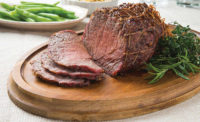Meat industry trends to watch for 2017
There will be changes, but the outlook seems positive for the meat industry.

Trending clean supply chain claims include "environmentally friendly" and "animal welfare."
Regardless of what political turmoil takes place in the country in 2017 and beyond, Americans will continue to eat, and if at all possible, they will continue to eat as well as their budget allows. That appears to be a good sign for the meat industry. The USDA projects that production of beef and pork will expand steadily between 2016 and 2025. The National Chicken Council, meanwhile, reports that consumers are eating more chicken than ever — approximately 92 pounds in 2016, according to USDA estimates — and are planning to increase that consumption in the future.
Just what kind of meat will consumers be eating in 2017 and beyond? According to consumer research, more of it will be grass-fed and humanely raised. Recent research from Innova Market Insights lists “clean supreme” is its top food trend.
“The demand for total transparency now incorporates the entire supply chain, as a clean label positioning becomes more holistic. Trending clean supply chain claims include “environmentally friendly,” which has shown a CAGR [compound annual growth rate] growth of +72% from 2011-2015 and “animal welfare,” which has grown at +45% per year during this period,” the company states.
In a separate report, research from Nielsen and the Wall Street Journal showed that sales of grass-fed products were $400 million over a 52-week period ending July 2, 2016. That represents a 50.1 percent increase.
The meat snack boom
At the National Association of Convenience Stores’ annual show in Atlanta this year, the exhibitor floor was filled with energy drinks, candy… and meat. Lots and lots of meat. There were at least two dozen meat processors at the show, most of which were showing off their jerky products, snack sticks and meat bars. Every taste and texture imaginable could be seen. Tough or tender jerky? Barbecue or Sriracha? Beef, pork or turkey snack sticks? Something more exotic, like a bison and cranberry meat bars? It’s fair to say that there was something for every meat snacker.
This category has seen small companies go all in for meat snacks and large companies enter with new products or company acquisition. There were multi-generational companies at the NACS show and businesses that started up within the last two or three years by entrepreneurs. While it may seem difficult for so many companies to succeed in the marketplace, there are positive signs that the snack market is only going to grow. Research from the International Dairy-Deli-Bakery Association shows that 83 percent of consumers are snacking daily, as opposed to 76 percent in 2014. While that research covered all food types, it can be assumed that more consumers will be turning to meat to satisfy their between-meal cravings.
Consumer convenience
When it comes to packaging, consumers want products that work for them. Danette Amstein, principal at Midan Marketing, says that companies that communicate differentiators will not only attract new customers but also ensure those customers remain loyal.
“We believe that calling out brand or package benefits, or offering smaller package sizes, provides added value to consumers based on recent research on Millennial and Baby Boomers’ shopping and cooking behaviors,” she says.
Case-ready packaging is a growing segment, as 60 percent of respondents in Midan’s Power of Meat research indicated that they considered case-ready packages equal in quality to meat cut in the store. Twenty-three percent believed the quality of pre-packaged meat was superior.
“Consumers want leak-proof, freezer-ready and resealable packaging. This needs to be a goal for our industry in order to help consumers see that our products can meet their changing needs,” she says.
Looking for a reprint of this article?
From high-res PDFs to custom plaques, order your copy today!






